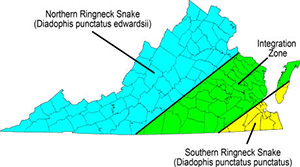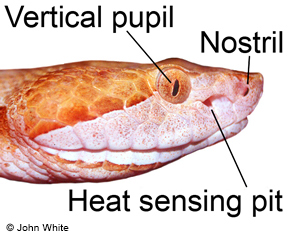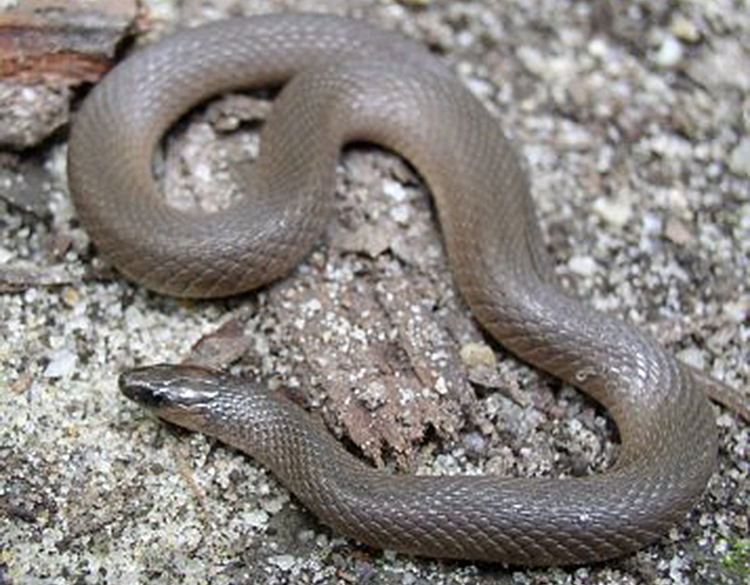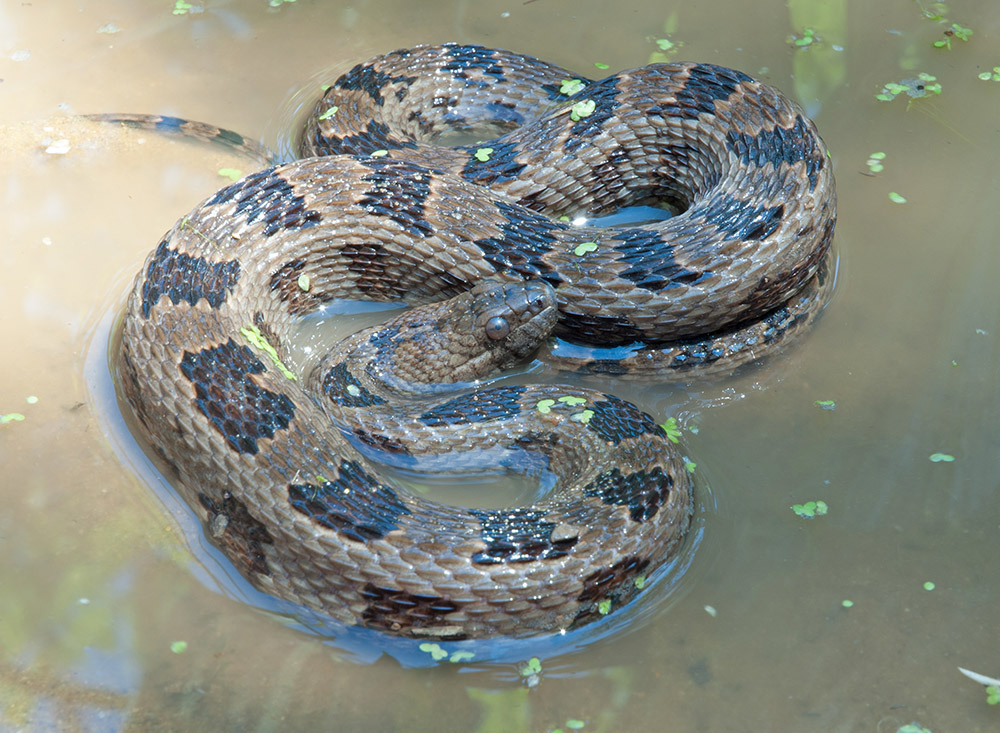Snake Identification Guide
Snakes Sorted by Total Body Length
Directions:
The identification keys are based on color, pattern and other physical characteristics. Each snake identification page has two options, A and B follow the options through the pages.
|
|
A - Snake has round pupils and no heat sensing pits --- Click Here - Section 4 | B - Snake has vertical pupils and heat sensing pits --- Click Here - Section 2 |
2 - Venomous
 |
 |

Distribution of the Timber Rattlesnake in Virginia
A - If the dorsal scales on the head small and/or snake has a rattle, then the snake is a Timber Rattlesnake (Crotalus horridus).
B - Dorsal scales on head enlarged, no rattle ----- Click Here - Section 3
3 - Venomous
 30990lr2.jpg) |
 |
715.jpg) |

Eastern Copperheads are found statewide.
A - If the body is reddish to light brown with darker hourglass-shaped cross bands, then the snake is a Eastern Copperhead (Agkistrodon contortrix).
012sm.jpg) |
 |
00223.jpg) |

B - If the body is black to olive, usually with a series of crossbands and brown stripe on side of head the snake is an Northern Cottonmouth (Agkistrodon piscivorus).
** Note: Often the harmless Northern Watersnake and Brown Watersnake are mistaken for the venomous Northern Cottonmouth. When compared side by side as in the photo below, it is difficult to understand how this mistaken identity occurs.

4 - Harmless
A - If the rostral scale (nose) is upturned and pointed, then the snake is a harmless Eastern Hog-nosed Snake (Heterodon platirhinos). The pattern and coloration of the eastern hognose snake can vary greatly.
 001232.jpg) |
 |
 001.jpg) |
The harmless Eastern Hog-nosed Snake is also well known for it acting ability, which includes hissing loudly, spreading of the neck to appear larger and playing dead. The snake rarely bites but will strike repeatedly with mouth closed.


B. Rostral scale rounded ----- Click Here - Section 5
5 - Harmless
 |
 |
A - Keeled scaled on dorsum (back) ----- Click Here - Section 6
 |

|
B - Dorsal scales smooth ----Click Here - Section 20
6 - Harmless
|

A - If 4 prefrontal scales on top of snout, then the snake is a Northern Pine Snake (Pituophis melanoleucus melanoleucus). *Note: The Northern Pinesnake is extremely rare in Virginia.

B - Two prefrontal scales present ----- Click Here - Section 7
7 - Harmless

A - Longitudinal stripes on the dorsum (back) and/or venter (belly). -------- Click Here - Section 8
B - No longitudinal stripes ----- Click Here - Section 11
8 - Harmless

A - Longitudinal yellowish stripe on midline of dorsum and on each side. ----- Click Here - Section 9
B - No stripe on the dorsum (back). Black stripes on venter (belly). ----- Click Here - Section 10
9 - Harmless
10991.jpg) |
 |
A - If the snake has lateral stripes on scale rows 3 and 4, then the snake is a Common Ribbonsnake (Thamnophis sauritus sauritus).
222.jpg) |
 |
B - If the snake has lateral stripes on scale rows 2 and 3, then the snake is an Eastern Garter Snake (Thamnophis sirtalis sirtalis).
10 - Harmless
 |
 |
A - If white to cream colored lateral stripe on scale rows 1 and 2; 4 brown stripes on venter (belly), outer 2 more prominent but stripes may fuse in some individuals to form a brownish venter (belly) with a cream colored midventral stripe; no dark stripes on sides of neck then the snake is a Queen Snake (Regina septemvittata septemvittata).
B - If no light lateral stripes; venter cream colored with 2 rows of black, half-moon shaped spots; three thin dark stripes on each side of neck then the snake is an Eastern Glossy Swampsnake (Liodytes rigida rigida).
11 - Harmless
|
|
A - If preocular scale not present; loreal scale elongated and touching the orbit the snake is a Rough Earthsnake(Haldea striatula).

B - One or two preocular scales present; loreal, if present, not elongated. ----- Click Here
12 - Harmless

A - Loreal scale absent ----- Click Here - Section 13
B - Loreal scale present ----- Click Here - Section 14
13 - Harmless
|
|
A - It the dorsum (back) is gray to brown with a row of paired, small black to dark-brown spots, which may border a light-brown middorsal stripe and one or more of which may be connected with crossbars; patch of dark pigment on supralabials 3 and 4 then the snake is a Dekay's Brownsnake (Storeria dekayi).
lr.jpg) |
.jpg) |
2.jpg) |
B - It the dorsum (back) is gray to brown with a collar on the neck consisting of three yellowish spots; venter (belly) bordered along each side with black the snake is a Red-bellied Snake (Storeria occipitomaculata occipitomaculata).
14 - Harmless
|
A - If the dorsum (back) is green with a width of 17 dorsal scales the snake is a Rough Greensnake (Opheodrys aestivus aestivus).

B - Dorsal scale width is equal to or greater than 21. ----- Click Here - Section 15
15 - Harmless
 |
 |
A - In cross section the body is shaped like a loaf of bread; venter (belly) flat; middorsal scales weakly keeled. ----- Click Here - Section 16
 |
 |
B - In cross section the body is round; all dorsal scales strongly keeled. ----- Click Here - Section 17
16 - Harmless
 |
 |
A - If the dorsum (back) has chest-nut brown blotches bordered in black; pattern on the top of the head looks like a spear point then the snake is a Corn Snake (Pantherophis guttatus).
|
|
|
B - If the dorsum (back) is black, some individuals may have faint outlines of black blotches; dorsum of head uniformly black then the snake is an Eastern Ratsnake (Pantherophis alleghaniensis).
17 - Harmless

A - Blotches present on the dorsum (back) of body. ----- Click Here - Section 18
B - Blotches not present on the dorsum (back) of body. ----- Click Here Section 19
18 - Harmless
|
|
A - If the dorsal (back) blotches brown and squarish, these alternate with similar blotches along sides; venter (belly) brownish without distinct spots then the snake is a Brown Watersnake (Nerodia taxispilota).
|
|
B - If dorsal (back) blotches occur as dark-brown crossbands anteriorly but change to alternating dorsal and lateral blotches posteriorly; venter (belly) pattern of half-moon shaped spots or peppering concentrated along the borders then the snake is a Northern Watersnake (Nerodia sipedon sipedon).
19 - Harmless
|
A - If the eye diameter is greater than or equal to the distance from the eye to the nostril then the snake is a Red-bellied Watersnake (Nerodia erythrogaster erythrogaster).
|
|
B - If the eye diameter is smaller than the distance from the eye to the nostril then the snake is a Northern Watersnake (Nerodia sipedon sipedon).
20 - Harmless

A - Black or colored collar on neck. ----- Click Here - Section 21
B - No collar or neck band. ----- Click Here - Section 22
21 - Harmless
|
|
A - If a uniformly light-brown dorsum (back) with a dark-brown to black head and snout; neck band of black, 3-4 scales wide separated from the head by a light brown band then the snake is a Southeastern Crowned Snake (Tantilla coronata).
|

B - If dorsum (back) is uniformly brownish or gray with yellow collar on neck; collar may be complete or broken at the dorsal midline then the snake is a Ringneck Snake (Diadophis punctatus).
22 - Harmless

A - Preocular scale present. ----- Click Here - Section 23
B - Preocular scale absent. ----- Click Here - Section 25
23 - Harmless

A - Dorsum (back) with longitudinal stripes of red and black, or dorsum black with alternating red and black patches on sides; dorsal scale rows greater than or equal to 18. ----- Click Here - Section 24
24 - Harmless
|
|

A - If one internasal scale present, then snake is an Eastern Mud Snake (Farancia abacura abacura).
|

B - Two internasal scales present, then snake is a Common Rainbow Snake (Farancia erytrogramma erytrogramma).
25 - Harmless

A - Mid-body scale rows less than or equal to 15. ----- Click Here - Section 26
B - Mid-body scale rows greater than or equal to 19. ----- Click Here - Section 27
|
|
C - If dorsum (back) uniformly gray to brown, with or without tiny black spots; dorsal 15 or 17 scales wide then the snake is an Eastern Smooth Earthsnake (Virginia valeriae).
26 - Harmless
|
|
A - If 13 mid-body scale rows then the snake is an Eastern Wormsnake (Carphophis amoenus amoenus).
|
B - If 15 mid-body scale rows and dorsum green then the snake is a Smooth Greensnake (Opheodrys vernalis).
27 - Harmless
|
|
|
|
A - If dorsum is uniformly black or blue then the snake is a Northern Black Racer (Coluber constrictor constrictor).

B - Dorsum with blotches or crossbands. ----- Click Here - Section 28
28 - Harmless

A - Anal plate single. ----- Click Here - Section 29
29 - Harmless
|
A - If cream colored to whitish dorsum (back) with red blotches bordered anteriorly and posteriorly with black but faded on sides; venter (belly) white; snout elongated and overlaps lower jaw then the snake is a Northern Scarlet Snake (Cemophora coccinea copei).
|
B - If the dorsum (back) is black with narrow yellow to white crossbands or with small yellowish spots; venter (belly) black then the snake is an Eastern Kingsnake (Lampropeltis getula getula).
C - If the dorsum (back) is gray to brown with reddish blotches distinctly bordered by black; venter (belly) with black and white checkerboard pattern; or body red rings separated from yellow rings by black rings that do not meet at the ventral midline then the snake is an Eastern Milksnake (Lampropeltis triangulum).
|
|
A - If dorsum is brown with narrow yellowish to reddish-brown blotches; center cream with faded dark smudges then the snake is a Mole Kingsnake (Lampropeltis calligaster rhombomaculata).
Last update: 17-Dec-2023




499909.jpg)
412.jpg)

.jpg)





001lr.jpg)
009992.jpg)


 007.jpg)

09992.jpg)

 009992lr.jpg)

0992.jpg)









